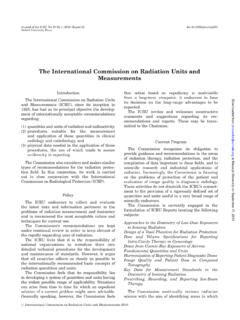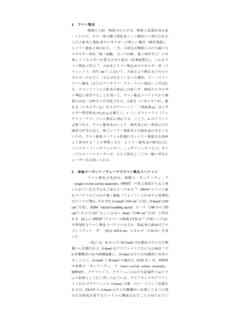Transcription of Lecture 14: Polarization - Harvard University
1 Matthew SchwartzLecture 14:Polarization1 Polarization vectorsIn the last Lecture , we showed that Maxwell s equations admit plane wave solutionsE~=E~0ei(k~ x~ t), B~=B~0ei(k~ x~ t)(1)Here,E~0andB~0are called thepolarization vectorsfor the electric and magnetic fields. Theseare complex 3 dimensional vectors. The wavevectork~and angular frequency are real and inthe vacuum are related by =c k~ . This relation implies that electromagnetic waves are disper-sionless with velocityc: the speed of light. In materials, like a prism, light can have will come to this addition, we found that for plane wavesB~0=1 (k~ E~0)(2)This equation implies that the magnetic field in a plane wave is completely determined by theelectric field.
2 In particular, it implies that their magnitudes are related by E~0 =c B~0 (3)and thatk~ E~0= 0, k~ B~0= 0, E~0 B~0= 0(4)In other words, the Polarization vector of the electric field, the Polarization vector of the mag-netic field, and the directionk~that the plane wave is propagating are all see how much freedom there is left in the plane wave, it s helpful to choose can always define thez direction as wherek~points. When we put a hat on a vector, itmeans the unit vector pointing in that direction, that isz = (0,0,1). Thus the electric field hasthe formE~=E~0ei (zc t)(5)which moves in thezdirection at the speed of light.
3 SinceE~0is orthogonal tok~we can writealso writeE~0= (Ex, Ey,0)(6)withExandEycomplex two complex amplitudesExandEyeach have magnitudes and phases. We can writethese explicitly asEx=|Ex|ei xandEy=|Ey|ei y. So one needs four real numbers to specifythe Polarization vector. We usually separte the phases intoan overall phase and the difference inphase betweenExandEy, = x y. The reason for doing this is that astandzchange thephases ofExandEychange in the same way while is unaffected. We don t usually care aboutthis overall phase, or about the overall magnitudeE=|Ex|2+|Ey|2.
4 Thus, to specify a polariza-tion vector, we talk about the relative size ofExandEyand the phase difference = x t let the complex Polarization vectors confuse you. We can just as wellE~=Exx cos(kz t+ x) +Eyy cos(kz t+ y)(7)where you see the four real numbers specifying the Polarization explicitly. Exponentials justmake a lot of the algebra Linear polarizationWe say a plane wave islinearly polarizedif there is no phase difference can write linear polarizations asE~0= (Ex, Ey,0)(8)and choose the overall phase so thatExandEyare real numbers. IfEy= 0butEx=/ 0, we haveE~=E0x ei(kz t)(9)withE0=|E~0|just a number now.
5 Then, from Eq. (2), sincez x =y ,B~=1cE0y ei(kz t)(10)This configuration is said to belinear polarized in the x we can haveE~=E0y ei(kz t)(11)and usingz y = x :B~= 1cE0x ei(kz t)(12)This configuration is said to belinear polarized in the y direction. Note that in both cases,the magnetic field is given by rotating the electric field 90 counterclockwise in thex-yplaneand dividing generally, for any unit vectorv we can haveE~=E0v ei(k~ x~ t)(13)which is linearly polarized in thev direction. The magnetic field will be polarized in direction90 behind the electric , we always implicitly want to have the real part of these fields.
6 So, for linearlypolarized light in thexdirection, the fields are actuallyRe[E~]= (E0cos(kz t),0,0),Re[B~]=(0,E0ccos(kz t),0)(14)Note that there is noxorydependence in these solutions: the fields are completely uniform inxandy they are plane waves. At each point on the plane, the electric field points in thex direction with the same magnitude. This magnitude varies aswe move inzand intbut isalways uniform in the s a picture of how the fields vary as they move along for a wave moving in thexdirec-tion:.2 Section 23 Circular polarizationWhat if the components of the electric field are not in phase?
7 First suppose the have the samemagnitude but are a quarter wavelength out of phase, so x y= 2. Then,E~0=(E0, E0ei 2,0)= (E0, iE0,0)(15)Thus,E~=(E0ei(kz t), iE0ei(kz t),0)(16)Taking the real part gives the actual electric fieldRe[E~]=(E0cos(kz t), E0sin(kz t),0)(17)This is calledleft-handed circularly polarized does it look like? Well, att=z= 0, the field is Re(E~)= (E0,0,0)pointing in thexdirection. A little farther along, whenkz= 2, still att= 0, then Re(E~)= (0, E0,0)whichpoints in the negativey direction. Farther along still, whenkz= , it points along x , and theny and so on.
8 Finally, after a full wavelength, it goes back tox . Thus, as we move alongz, thepolarization rotates clockwise in thex-yplane. Equivalently, at a givenz, as time progresses italso rotates in is a pictureFigure polarized light changes the direction of its Polarization as it , taking x y= 2givesE~0= (E0, iE0,0)Re[E~]= (E0cos(kz t), E0sin(kz t),0)(18)which isright-handed circularly polarized light. In this case, att= 0andkz=0, the polar-ization points in thex direction. A quarter wavelength farther, it points in they direction, andso one. So this field rotates counterclockwise in that when we add left and right handed polarizations we getE~0= (E0, iE0,0) + (E0, iE0,0) = (2E0,0,0)(19)which is linearly polarized in thex direction.
9 Similarly, subtracting them gives linear polariza-tion in they direction. Thus circular and linear polarizations are not linearly , any possible Polarization can be written as a linearly combination of left-handed andright-handed circularly polarized polarized light has angular momentum e0 E~ 2k , with the positive sign for left-handed and the negative sign for right-handed. Linearly polarized light carries no angularmomentum. This is easy to understand because it is a sum of left and right handed light. As ananalogy, suppose you have two tops, one spinning clockwise and one spinning counterclockwise;the two-top system has no net angular polarization3As mentioned before, light cannot have arbitrarily small intensity.
10 The smallest intensitylight can have is a single photon . Thus the photon itself mustbe polarized. A single circularlypolarized photon has angular momentumJ~= h2 k . It may seem surprising that photons whichare pointlike particles with no substructure can have angular momentum on their own. It is avery odd fact, but true nonetheless. Photons havespin. We say photons are particles of spin two signs for the angular momentum correspond to the two helicities of the complete the discussion of Polarization , we can consideralso varying the magnitudes ofthe different components and the phase.
















